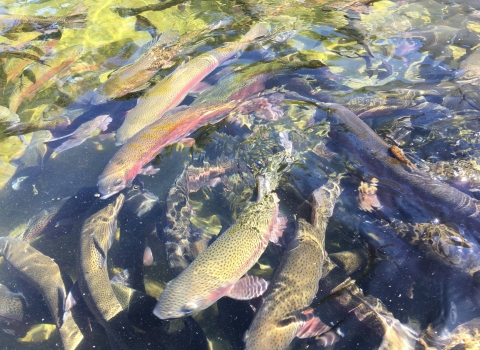The U.S. Fish and Wildlife Service (Service) completed a horse gather last week on Sheldon National Wildlife Refuge near Denio, Nevada, resulting in the capture of 396 horses. Of the horses captured, approximately 250 will be offered for adoption through contracted adoption agents. The remaining horses will receive contraception and be returned to the refuge.
Management of horse and burro populations on Sheldon Refuge is required to limit damage to wildlife habitat, consistent with the purpose of the refuge. The 575,000-acre refuge was established to conserve pronghorn antelope and other native species of the sagebrush sagebrush
The western United States’ sagebrush country encompasses over 175 million acres of public and private lands. The sagebrush landscape provides many benefits to our rural economies and communities, and it serves as crucial habitat for a diversity of wildlife, including the iconic greater sage-grouse and over 350 other species.
Learn more about sagebrush steppe ecosystem, such as sage grouse, prairie falcons, pygmy rabbits, pika and songbirds.
Horse gathers and other horse and burro management activities (such as contraception, monitoring, research, and fencing) are described in the 2008 Horse and Burro Management Plan and Environmental Assessment (http://www.fws.gov/sheldonhartmtn/Sheldon/horseburro.html). The interim population objective for horse and burro management plan is to limit the number of animals to about 800 horses and 90 burros, until the completion of a Comprehensive Conservation Plan and Environmental Impact Statement (CCP/EIS). Members of the public can learn about and sign up to comment on the CCP/EIS at the following website: http://www.fws.gov/pacific/planning/main/docs/NV/docssheldon.htm
The Service seeks to conduct gathers in a safe and humane manner, with practices described in the horse and burro management plan. Specific areas during gather operations are closed to the public, unless escorted, to ensure operations are safe for both horses and people, and that work can be completed efficiently. Public viewing areas for unattended observation are arranged when possible.
Four mortalities were observed in last week's gather. Two horses were brought in with injuries on the range prior to the gather and were euthanized after a veterinarian was consulted. Two other horses suffered mortal injury from the gather. An independent expert (veterinarian and health/animal welfare inspector) is contracted to observe the gather and handling operations and produce a report, which is available upon request.
"We regret any loss of horses and we take extensive precautions to ensure the gathers are conducted in a safe, humane way that minimizes the risk of injuries," said Paul Steblein, Project Leader of the Sheldon-Hart National Wildlife Refuge Complex. "We are proud of our record on managing horses and we continuously seek improvements."
Horse management in the last couple years has focused on reducing the number of horses and burros in the northern part of the refuge to reduce vehicle collisions, which have killed five to 10 horses and burros each year. Refuge staff has observed a pronounced drop in animal-related accidents on State Route 140 through the refuge since the horse and burro gathers were focused on areas adjacent to the highway.
All animals removed from the refuge during gathers go into an adoption program, also described in the refuge website and management plan. People interested in adopting horses or burros should contact the refuge or adoption agents listed on the refuge website. Potential adopters need to demonstrate that they have adequate facilities, experience and knowledge to care for the animals.
Other areas of focus for management of horses and burros on Sheldon Refuge
include:
- Monitoring: completing both aerial census and statistical counts of horses from 2008-2010, mapping vegetation for the entire refuge,
assessing condition of 180 springs and water developments. - Research: conducting a 5-year exclosure experiment to identify the effect of horses on soil compaction, flow of water in spring brooks, plant species/cover/abundance, and invertebrate species and abundance. These factors directly affect the quality of habitat for many species of wildlife.
- Fencing: closure of the refuge boundary to keep horses and burros from moving between the refuge and adjacent lands managed by the Bureau of Land Management (BLM). Contraception: developing and evaluating techniques to limit reproduction of horses on the refuge.
- Gathers: continued refinement of facilities and operations to improve the efficiency and safety for horses and burros.
The Service recently signed a Memorandum of Understanding (MOU) with the BLM to cooperate and coordinate on horse and burro management activities in a roughly 4 million-acre area located at the junction of Oregon, Nevada and California. This summer, a unified survey was conducted across the coordination area to produce statistical estimates of horse numbers and distribution.


